Academic essay writing stands at the center of scholarly communication, demanding clarity of thought, structured reasoning, and credible evidence. It is both a demonstration of understanding and an act of discovery—showing how ideas develop through analysis and reflection. This article explores the full process of producing an academic essay that is precise, persuasive, and research-driven, drawing on recent studies in writing pedagogy and cognitive learning to help readers approach each stage with confidence and purpose.
What is an Academic Essay
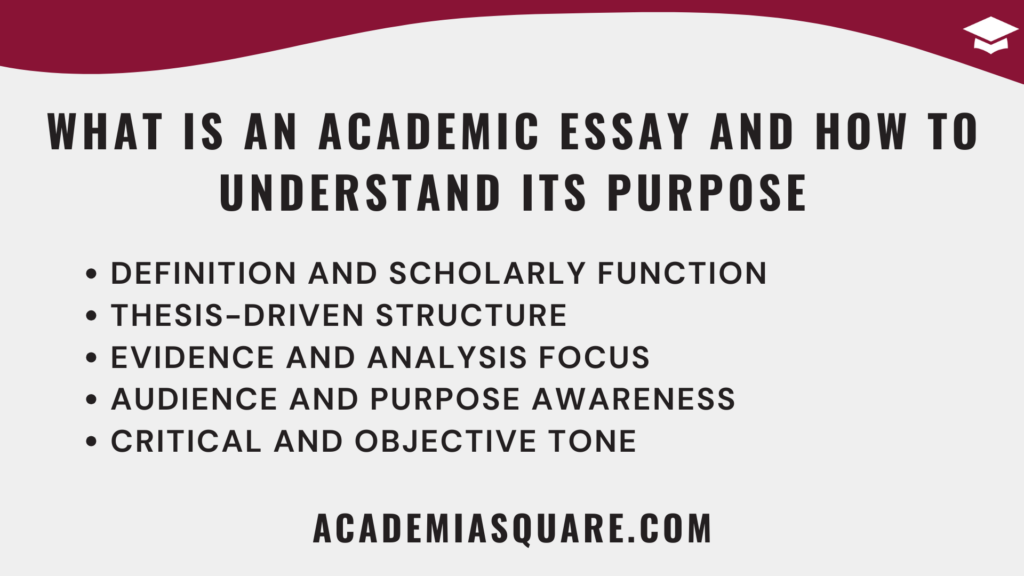
Academic essay writing is a structured form of expression used in higher education to communicate ideas through evidence, analysis, and logical organization. It differs from casual or creative writing because its goal is not only to express personal thought but also to demonstrate critical reasoning within a discipline. A strong academic essay presents a clear thesis, supports it with credible research, and leads the reader through a coherent argument from introduction to conclusion.
At its core, an academic essay is a dialogue between the writer and the scholarly community. It invites readers to consider, question, or build upon your reasoning. According to the Purdue Online Writing Lab, academic writing is characterized by clarity, formality, and objectivity—qualities that allow readers to trust the logic and evidence presented. Unlike opinion pieces, academic essays rely on verifiable sources and transparent argumentation to sustain credibility.
Essential Features of an Academic Essay
Although expectations vary across disciplines, most academic essays share a similar framework. Understanding these elements helps writers craft arguments that meet university standards and engage scholarly readers.
- Thesis-driven structure: Every academic essay revolves around a central claim or question that gives direction to the entire piece.
- Evidence-based reasoning: Claims must be supported by data, citations, or theoretical references rather than personal opinion.
- Formal tone and style: Precision, clarity, and neutrality replace conversational or emotional expression.
- Logical organization: Each paragraph contributes to a coherent progression of ideas and connects clearly to the essay’s main argument.
- Critical reflection: Beyond describing information, an academic essay interprets, evaluates, and situates knowledge within a broader context.
The University of North Carolina Writing Center explains that academic essays not only demonstrate understanding but also contribute new insight through synthesis and evaluation. In this way, writing becomes an act of learning rather than simple reporting.
- 🧠 Structured Thinking: A 2024 review in the Written Communication journal found that students who used explicit essay structures produced writing rated 35% higher in coherence and argument strength.
- 📚 Critical Engagement: Research from the Journal of Writing Research (2022) showed that essays combining description and critical commentary scored better on analytical depth and originality.
- 🎓 Purpose Awareness: Studies by Dunlosky et al. (2013, Learning and Instruction) demonstrated that writers who clearly identify purpose and audience early in the process retain better focus and produce higher-quality arguments.
Understanding the Assignment and Its Purpose
Once you understand what an academic essay is, the next step is to interpret your specific assignment. The prompt you receive outlines expectations, objectives, and constraints. Misreading it can cause you to answer the wrong question or miss essential criteria. Treat the assignment as both a contract and a guide—it defines what success looks like for your essay.
Pay attention to key verbs in the prompt such as “analyze,” “compare,” or “evaluate.” These indicate the type of intellectual work expected from you. “Analyze” asks for breaking down ideas into parts and examining relationships, while “evaluate” requires forming judgments based on evidence or theory. Identifying these cues helps you determine whether your task is explanatory, persuasive, or analytical.
- What is the central question or issue the essay must address?
- What type of thinking—argument, explanation, or interpretation—is required?
- Who is your intended reader, and what background knowledge can you assume?
The University of Southern California Writing Guide emphasizes that awareness of audience and purpose improves alignment with grading criteria and reduces unnecessary revisions later. Clarity at this stage transforms the writing process from guesswork into deliberate problem-solving.
When you know what defines an academic essay and you understand what your assignment truly demands, you are ready to begin the creative and analytical work of topic selection and research. Every strong paper begins with this foundation: knowledge of the genre, clarity of purpose, and a precise understanding of what the essay must achieve.
Selecting a Topic and Framing the Research Question

Academic essay quality begins long before the first draft. The strength of your final work depends on how clearly you choose and define your topic. Selecting a subject that is both interesting and feasible creates the intellectual foundation for an essay that is focused, original, and research-driven. A good topic strikes balance: narrow enough to explore in depth but broad enough to connect with larger academic conversations.
Before committing to a topic, reflect on your interests, course objectives, and available sources. Research from the Learning and Instruction journal (Dunlosky et al., 2013) found that students who invested time in refining their essay topic before writing produced arguments with higher coherence and stronger thesis alignment.
How to Choose a Topic That Works
When selecting your topic, avoid vague or overly general themes such as “education” or “climate change.” Instead, identify a specific angle or problem that can be explored within your essay’s length. For instance, “the effect of digital tools on student writing development” is more manageable and researchable than “technology in education.”
- Start from your course readings or lecture discussions and note recurring issues or controversies.
- Check recent publications in academic journals for emerging questions or debates.
- Consider what evidence or data are accessible to you through your institution’s library or databases.
Effective topic selection involves both curiosity and practicality. Ask yourself whether you can sustain interest across the full writing process and whether credible sources are available to support your argument.
Framing the Research Question
Once you have a tentative topic, the next step is to transform it into a research question. A well-framed question defines the essay’s scope and sets a clear direction for your argument. The University of North Carolina Writing Center recommends shaping questions that are specific, arguable, and open to interpretation rather than simple fact-finding.
Strong academic questions often begin with phrases such as “to what extent,” “how does,” or “why does.” These invite exploration rather than summary. For example, instead of asking “What is online learning?” ask “How does online learning affect student motivation in first-year university courses?”
Before you move on, ensure your question meets three tests:
- It cannot be answered with a simple yes or no.
- It invites multiple perspectives and critical evaluation.
- It connects to credible evidence and existing research literature.
Defining your question early creates focus and efficiency. It helps you filter information, organize structure, and sustain argument consistency from introduction to conclusion. Writers who skip this step often drift between unrelated ideas and weaken their essay’s impact.
A clear topic and question are the twin anchors of a successful academic essay. They transform a broad idea into a purposeful inquiry, guiding every decision you make during research and drafting.
Conducting Research and Gathering Evidence
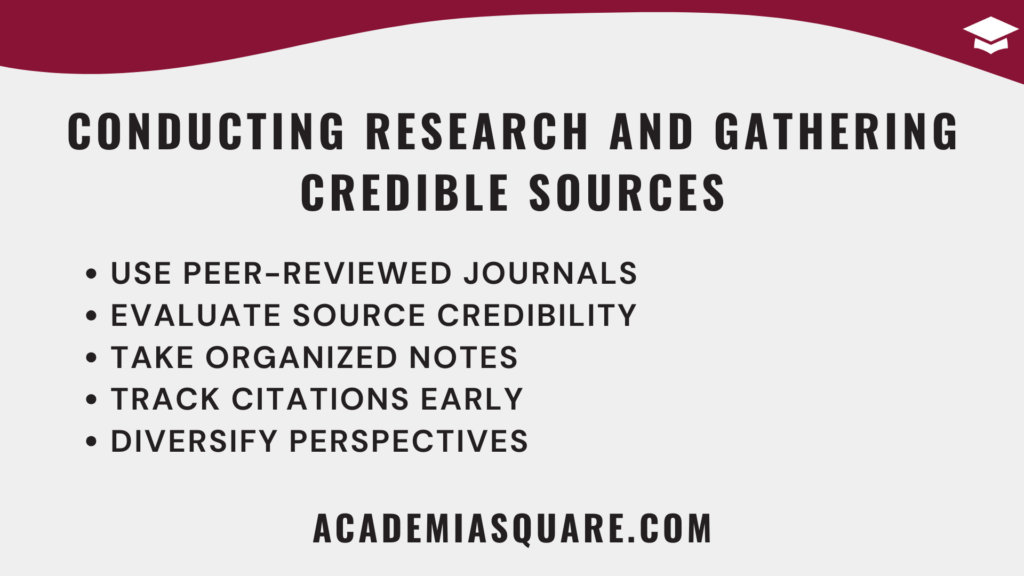
Academic essay excellence relies on the quality of its research. Once your topic and question are clear, the next task is to locate credible evidence that supports your reasoning. Academic writing values sources that are scholarly, peer-reviewed, and contextually relevant. The more rigor you apply at this stage, the stronger your argument will become.
Research is not about collecting as many sources as possible—it is about choosing the right ones. The Harvard College Writing Center emphasizes that the best writers learn to read critically, distinguishing between sources that inform background knowledge and those that directly advance an argument.
Finding Reliable Sources
Begin by searching in academic databases such as JSTOR, Google Scholar, or your university’s digital library. Avoid relying on popular media or unverified blogs. Scholarly sources usually include journal articles, academic books, and official reports. Reading abstracts first helps determine whether a text is truly relevant to your question.
- Use database filters to limit results by year or discipline.
- Track recurring authors or concepts—they often define the scholarly conversation around your topic.
- Take concise notes with full citation information to avoid plagiarism later.
When possible, prioritize peer-reviewed studies, as these have been evaluated for methodological and factual accuracy. A 2022 analysis by the Written Communication journal confirmed that essays integrating peer-reviewed research are perceived as more authoritative and balanced.
Evaluating and Synthesizing Evidence
Not all sources contribute equally. Evaluate each for credibility, recency, and relevance. Ask: Who is the author? What methods or data support their claims? Does the argument align or contrast with other literature? Building synthesis means connecting multiple sources to identify patterns, disagreements, and gaps. This process moves you from passive reading to active thinking.
Effective note-taking strategies include creating concept maps or comparison tables that visualize how different authors address similar questions. By the time you begin drafting, your research should already suggest a tentative thesis or direction for your argument.
Research is both foundation and discovery. Treat it as an intellectual dialogue where each source becomes a voice in a larger conversation that your essay continues.
Crafting a Thesis Statement for Your Academic Essay
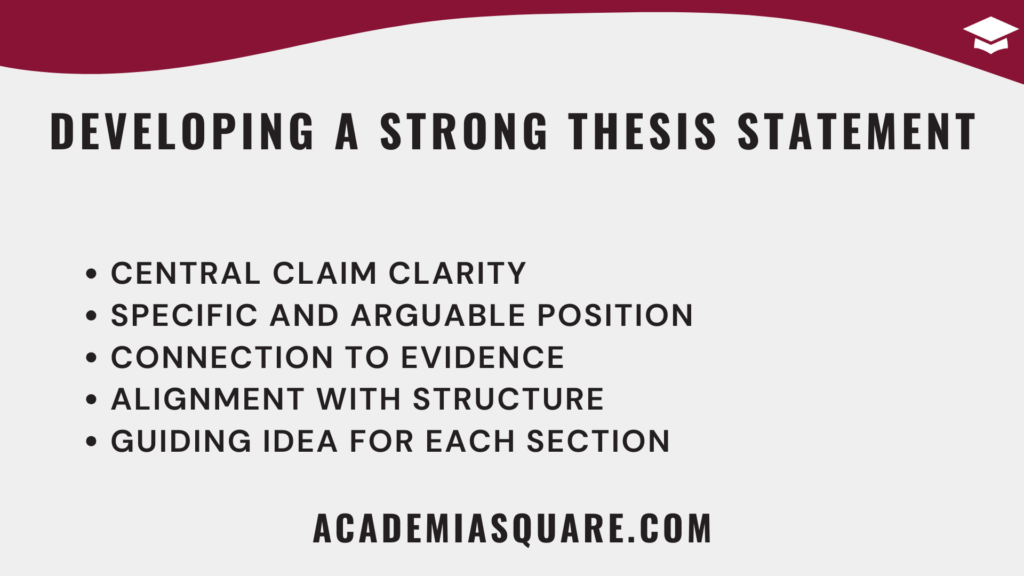
Academic essay writing depends on a clear thesis statement—the single sentence that expresses your central argument or position. A strong thesis is precise, arguable, and rooted in evidence. It gives readers a map of what to expect and gives you a compass to maintain focus during drafting and revision. Without it, an essay risks becoming a disconnected sequence of ideas.
Qualities of an Effective Thesis
The UNC Writing Center defines a thesis as a claim that “interprets, evaluates, or analyzes,” not merely describes. A descriptive statement such as “Online learning is common in universities” lacks argument. A stronger version might read, “Online learning enhances student autonomy but risks reducing peer collaboration, requiring balanced instructional design.”
- Specificity: It focuses on one main idea, avoiding vague generalizations.
- Debatability: It invites discussion rather than restating facts.
- Scope: It fits within the essay’s word limit while addressing a meaningful question.
- Evidence foundation: It aligns with sources that you can actually support through research.
In short, a thesis answers your research question while implying the structure of your argument. Readers should be able to predict the essay’s flow from this sentence alone.
Developing and Refining Your Thesis
Writers rarely arrive at a perfect thesis immediately. It evolves through reading, note-taking, and critical thinking. As you collect evidence, ask whether your main claim still holds or requires adjustment. Revision is part of intellectual honesty. The Educational Psychologist journal (Kellogg, 2013) reports that iterative thesis refinement leads to essays with clearer reasoning and higher analytical depth.
A productive approach is to draft a working thesis early, then revisit it at three points: after initial research, after outlining, and after the first draft. This practice ensures your claim stays aligned with evolving insight.
Testing Your Thesis for Strength
Before moving on, subject your thesis to a quick diagnostic test:
- Can someone reasonably disagree with it?
- Does it require supporting evidence rather than personal belief?
- Does every major paragraph you plan connect directly to it?
If you can answer yes to all, your thesis is ready to guide drafting. A well-designed thesis brings structure, purpose, and intellectual coherence to your academic essay, turning a general topic into a reasoned and persuasive argument.
Designing the Structure and Outline of Your Academic Essay
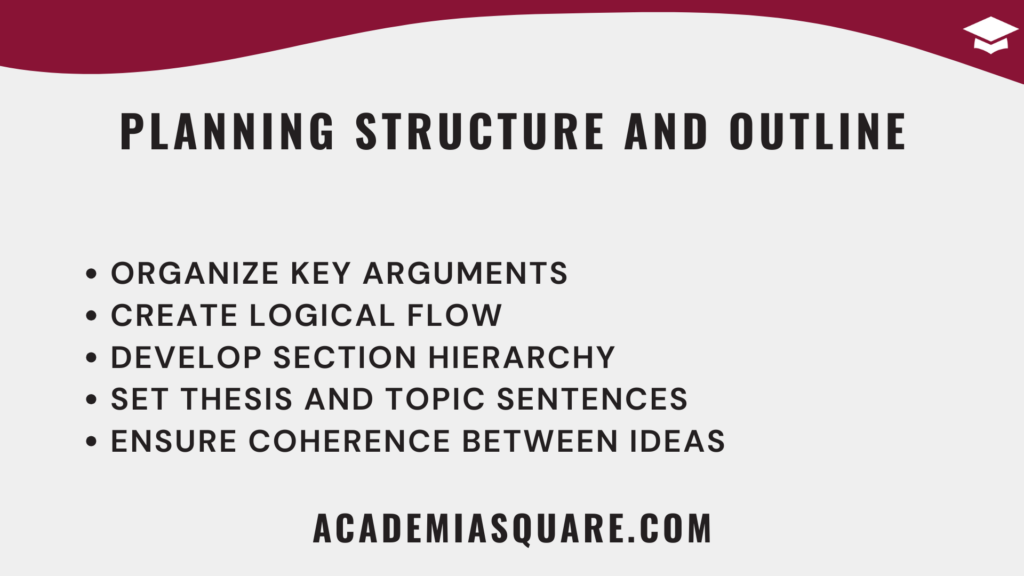
Academic essay structure determines how clearly your ideas reach the reader. Even the most insightful argument loses power without logical organization. A well-designed outline transforms abstract thinking into a coherent path from introduction to conclusion. It also prevents writer’s block by making each section’s purpose visible before drafting begins.
According to the Purdue OWL Writing Lab, essays that follow clear structural planning demonstrate higher reader comprehension and stronger argumentative flow. Outlining is not busywork—it is intellectual architecture that shapes reasoning into form.
The Classical Structure of an Academic Essay
Most academic essays follow a three-part structure, with additional sections as needed for complex arguments:
- Introduction: Presents context, outlines the issue, and ends with the thesis statement.
- Body Paragraphs: Each develops one central idea or step in the argument, supported by evidence and analysis.
- Conclusion: Synthesizes findings, revisits the thesis in light of discussion, and reinforces implications.
Although simple, this model works across disciplines because it mirrors the way readers process logic: orientation, exploration, and resolution. A clear structure allows readers to follow reasoning without confusion or repetition.
Creating a Functional Outline
An outline is a working plan, not a rigid rule. Start by listing main sections, then expand each with subpoints or potential evidence. Good outlines show not just what will appear but why each point belongs. Each section should clearly serve your thesis and transition naturally to the next.
Ask yourself:
- Does every main section directly advance my thesis?
- Are the points in logical order—from background to analysis to conclusion?
- Is there balance between sections, or does one dominate without purpose?
Writers who use structured outlines write faster and revise less. Clarity in structure frees cognitive energy for creativity, analysis, and stylistic refinement later.
By mapping your essay before writing, you replace uncertainty with intention. The outline becomes both a navigation chart and a productivity tool that ensures no essential part of your argument is lost along the way.
Writing an Engaging Introduction and Clear Roadmap
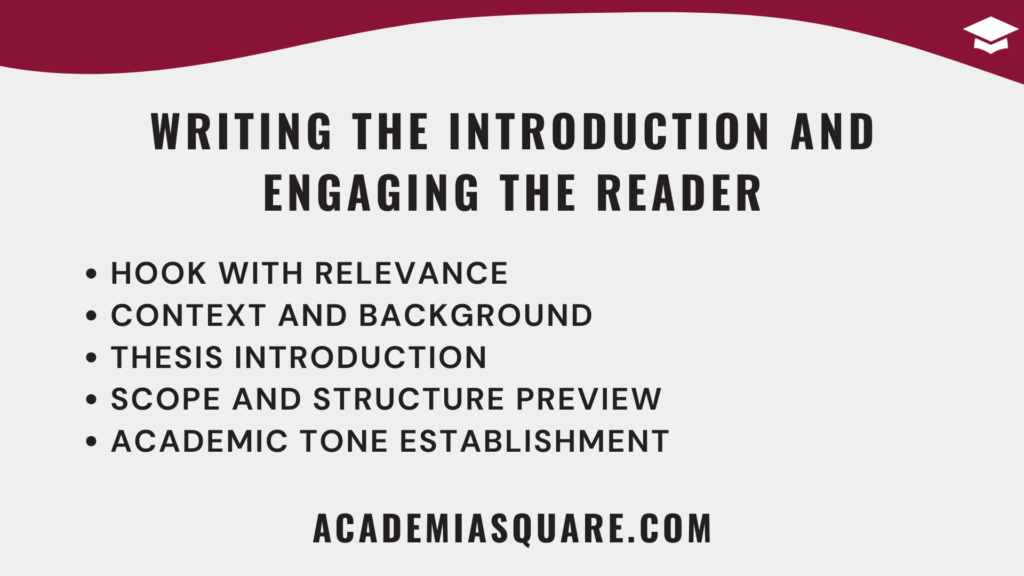
Academic essay introductions serve a dual role: they capture attention and establish intellectual direction. A strong opening provides readers with motivation to continue while signaling your essay’s focus and argument. According to the UNC Writing Center, the best introductions combine context, purpose, and preview—guiding readers from general background to specific claim.
How to Build an Effective Introduction
Begin by situating your topic within a larger context. Identify why the issue matters or what problem it addresses. Avoid vague statements like “Throughout history…” or “Many people think…” Instead, ground your essay in a precise context that leads to your argument. The introduction should move logically from background to focus, culminating in your thesis.
- Start with a concrete observation, question, or brief example relevant to your topic.
- Introduce the academic or practical issue your essay addresses.
- End with your thesis statement and a brief outline of the essay’s structure.
Think of the introduction as a funnel: it begins broad enough to establish relevance and narrows to the specific claim you will defend. The Journal of Writing Research (2022) reported that readers form first impressions of writing quality within the first 150 words, making clarity and focus in the opening section critical to engagement.
Creating a Roadmap for the Reader
After stating your thesis, include a roadmap—a short preview of how the essay will unfold. This signals control and organization. For example:
This essay first examines existing research on student engagement, then evaluates classroom practices that promote motivation, and finally proposes a reflective model for sustained learning.
This type of roadmap helps readers anticipate structure and assess argument flow. It also forces you, the writer, to plan progression before drafting. The most effective introductions answer three questions: What is this essay about? Why does it matter? How will it unfold?
By combining relevance, clarity, and direction, your introduction transforms from a generic opener into a persuasive invitation for intellectual exploration.
Developing Body Paragraphs with Argument, Evidence, and Analysis
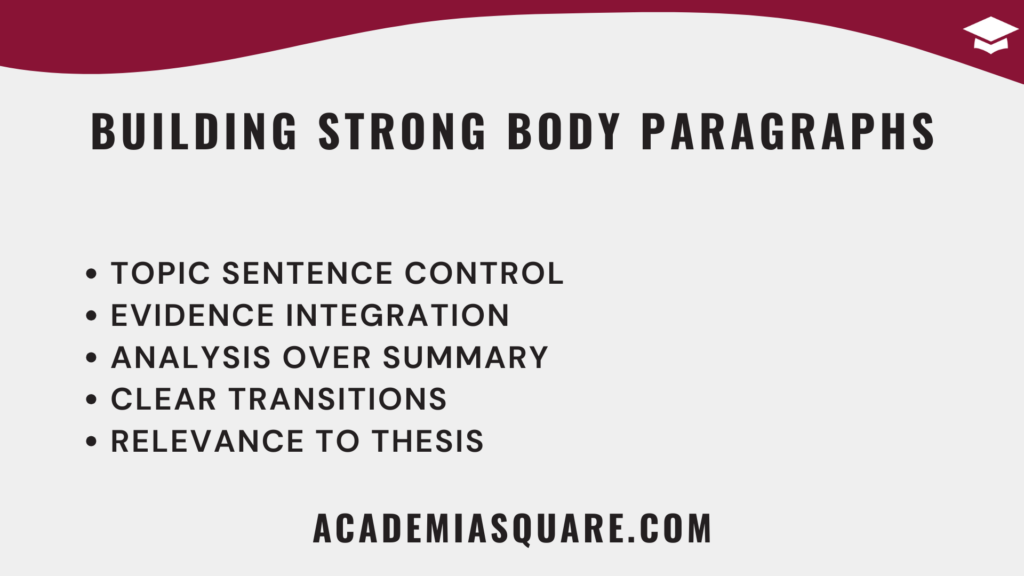
Academic essay body paragraphs carry the full weight of your argument. Each paragraph must develop one central idea and connect clearly to your thesis. The quality of your essay depends on how well these sections integrate evidence with reasoning. Good paragraphs do more than present data—they interpret, compare, and evaluate it.
The Harvard Writing Center notes that strong paragraphs follow a predictable internal logic: topic sentence, evidence, analysis, and transition. This consistency helps readers follow complex arguments without confusion.
Building Analytical Paragraphs
Each paragraph should begin with a clear topic sentence that ties directly to your thesis. Follow with evidence—data, quotations, or examples—and conclude with analysis that explains how this evidence supports your point. Avoid dropping quotations or facts without interpretation; they must always serve your argument.
- Topic Sentence: Introduces the central idea of the paragraph.
- Evidence: Presents factual or textual support drawn from reliable sources.
- Analysis: Interprets evidence, connecting it back to the thesis.
- Transition: Bridges the current paragraph to the next logically.
Integrating Evidence with Purpose
Effective integration means connecting data or quotations to interpretation. Signal phrases such as “This suggests,” “This demonstrates,” or “This contrasts with” help guide the reader through reasoning. Overreliance on quotations without explanation weakens authority. Paraphrasing often shows deeper understanding and allows smoother argument flow.
According to a 2022 review in the Journal of Academic Development, essays that alternate between evidence and analysis rather than clustering all citations at once are rated as more coherent and professional.
Maintaining Logical Flow
Transitions between paragraphs are as important as structure within them. Use signposting phrases such as “In contrast,” “Building upon this idea,” or “Similarly” to indicate logical movement. Readers should feel guided through a seamless sequence of reasoning, not pushed through disconnected claims.
When body paragraphs are crafted deliberately—with clear claims, relevant evidence, and reflective analysis—the essay gains both intellectual depth and readability. This stage is where your research comes alive as argument, transforming knowledge into insight and insight into persuasive writing.
Integrating Sources and Avoiding Common Pitfalls
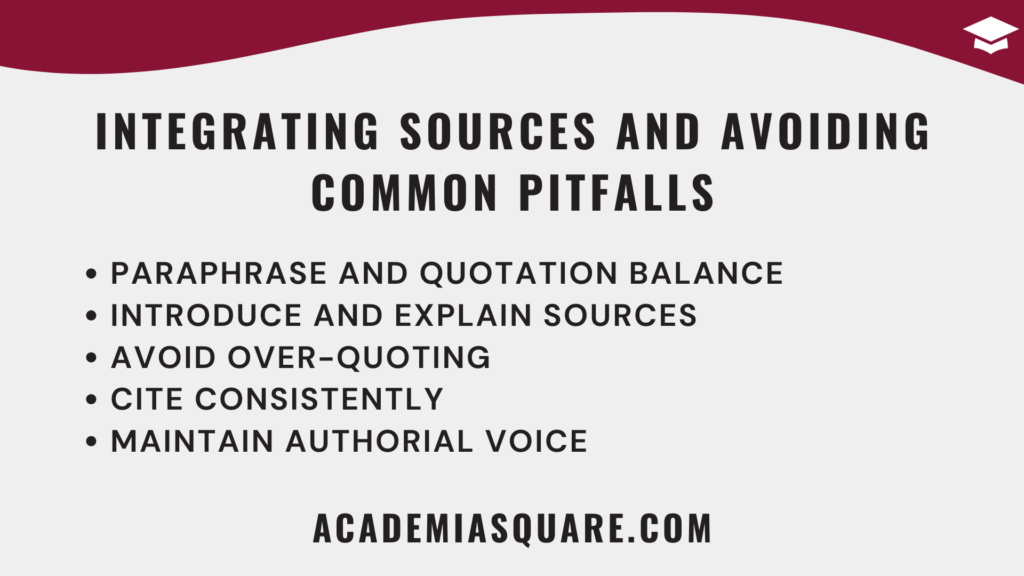
Academic essay writing depends on the thoughtful integration of sources. Using evidence correctly shows your ability to engage critically with scholarship rather than simply repeat it. The goal is to build a dialogue between your voice and the ideas of others while maintaining intellectual ownership of your argument.
As the University of North Carolina Writing Center explains, effective source integration requires balance: too few citations weaken credibility, while excessive quotation reduces originality. The challenge is to select evidence strategically and comment on it insightfully.
How to Integrate Sources Effectively
When using sources, always introduce them before quoting or paraphrasing, and interpret them afterward. This “sandwich” method ensures that the reader understands why the source is relevant. For example:
As Hyland (2019) notes, disciplinary writing depends on the writer’s awareness of genre expectations. This observation highlights how academic essays must adapt structure and tone to disciplinary norms.
- Introduce the source and author to provide context.
- Present the evidence clearly through quotation or paraphrase.
- Follow with analysis that connects the source to your argument.
Paraphrasing is often more powerful than quoting because it forces you to process meaning rather than copy structure. However, direct quotations are appropriate when language itself is significant or especially well phrased.
Common Mistakes in Source Use
Some frequent issues in academic essay writing include:
- Over-quoting: Using long blocks of text without commentary weakens your argument.
- Patchwriting: Paraphrasing too closely to the original wording, which may lead to plagiarism.
- Unbalanced authority: Relying heavily on one author or perspective instead of engaging multiple viewpoints.
- Missing citations: Forgetting to credit ideas even when not quoting directly.
Use reference management tools like Zotero or Mendeley to maintain citation accuracy. Each source you use should have a clear reason for inclusion. Your goal is synthesis, not accumulation.
When done well, source integration enhances your credibility and positions your essay within scholarly conversation—showing not only what you know but how you think critically about what others have written.
Writing a Strong Conclusion and Reflecting on Impact
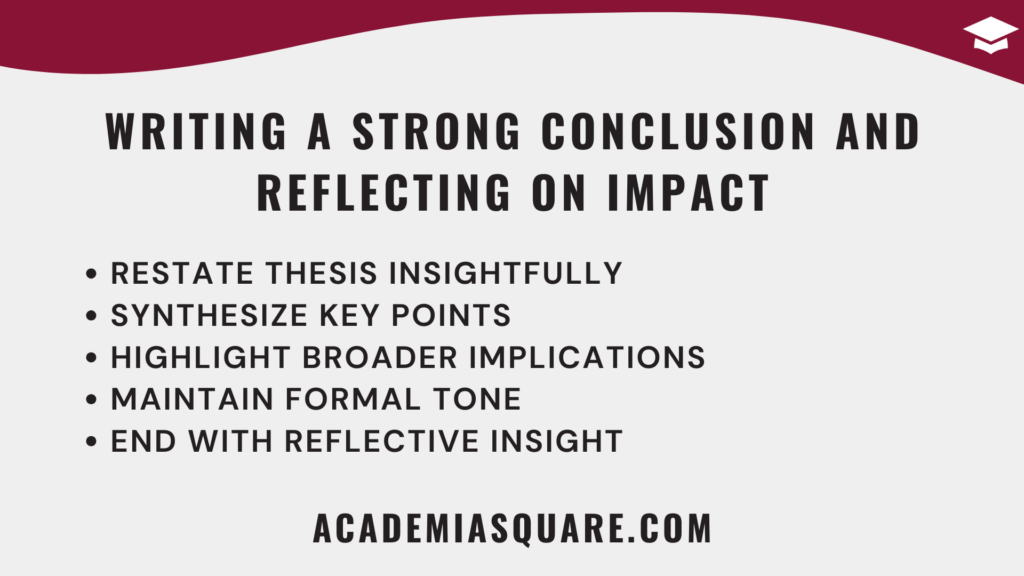
Academic essay conclusions are more than summaries; they are interpretive moments where you reveal the significance of your argument. A strong conclusion reminds readers why your thesis matters and leaves them with a sense of intellectual closure. It should not introduce new evidence but rather demonstrate how everything discussed fits together logically and conceptually.
The Harvard Writing Center describes conclusions as the “final act of persuasion.” They reaffirm the essay’s argument, reflect on its implications, and sometimes point toward areas for future inquiry.
Elements of an Effective Conclusion
Good conclusions usually include three parts:
- Restated Thesis: Revisit your main claim in light of the evidence presented rather than repeating it word for word.
- Synthesis of Key Points: Show how the arguments developed throughout the essay collectively support your thesis.
- Broader Significance: Explain why your findings or reasoning matter beyond the essay itself—academically, socially, or practically.
Consider this example: if your essay examined how feedback loops improve student writing, the conclusion might discuss how those insights inform teaching practice or future research directions.
Reflecting on the Essay’s Contribution
Use your conclusion to remind readers what new understanding your essay offers. What does your analysis add to the conversation about your topic? What assumptions does it challenge or confirm? Academic writing rewards reflection as much as reasoning. Showing awareness of implications demonstrates maturity as a scholar.
Avoid mechanical phrases like “In conclusion” or “To sum up.” Instead, transition naturally into reflection by echoing key terms from your thesis and re-emphasizing your argument’s significance. End with purpose and precision, leaving readers with a sense of closure and insight that extends beyond the page.
Revising and Refining Your Academic Essay for Clarity and Coherence
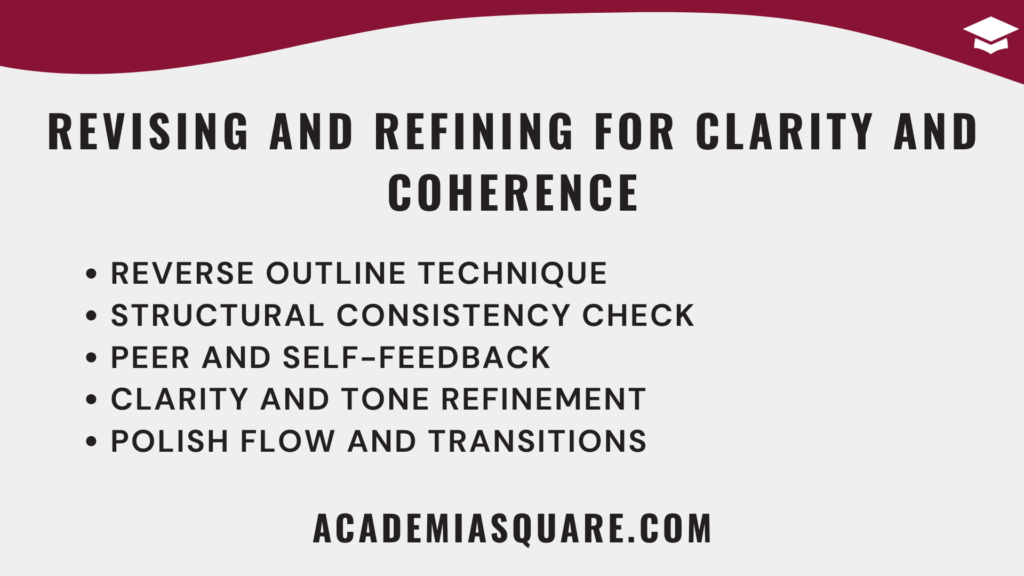
Academic essay revision is where writing becomes precise, persuasive, and polished. Revision is not mere editing—it is the process of re-seeing your work to enhance structure, logic, and meaning. According to Dunlosky et al. (2013, Psychological Science in the Public Interest), systematic revision improves comprehension and clarity more effectively than any single writing technique.
During revision, focus on how ideas connect rather than on surface correctness. Check whether each paragraph advances the thesis and whether transitions clearly signal relationships between ideas. Strong writers treat revision as intellectual refinement, not punishment.
Strategies for Effective Revision
- Reverse Outline: Write a one-sentence summary of each paragraph to ensure logical sequence and relevance.
- Structural Review: Examine whether your introduction forecasts the essay’s order and your conclusion fulfills it.
- Reader Perspective: Read aloud to detect awkward phrasing and disjointed flow.
- Peer Feedback: Ask a classmate or mentor to identify unclear sections or gaps in reasoning.
Revision is recursive; you may return to earlier stages of writing as new insights appear. The UNC Writing Center emphasizes that seeing revision as exploration rather than correction fosters creativity and deeper learning.
Deepening Coherence and Style
Once structure is sound, refine tone and phrasing. Replace vague words with precise ones, vary sentence length for rhythm, and ensure topic sentences link to the thesis. Remove redundancy, filler transitions, or repeated ideas. Attention to stylistic flow enhances reader trust and engagement.
Revision should end with confidence that your ideas are not only correct but also compelling. Each pass through the essay brings greater alignment between purpose and expression. A refined essay is the visible outcome of invisible thinking—the disciplined reflection that distinguishes competent writing from exceptional scholarship.
Editing Proofreading and Finalizing Formatting and Citations
Academic essay editing transforms a clear draft into a professional piece of writing. While revision focuses on meaning and logic, editing refines precision, tone, and consistency. Proofreading then ensures accuracy at the level of grammar, punctuation, and formatting. Together, these steps make your essay not only correct but credible and polished.
The University of North Carolina Writing Center distinguishes editing from proofreading: editing improves readability and flow, while proofreading detects minor errors. Both are essential for ensuring your essay meets academic expectations.
Editing for Style and Flow
Editing is the stage where you refine expression. Focus on conciseness, variety, and clarity. Replace vague or repetitive words with precise terms, and ensure sentences transition smoothly. Each paragraph should begin with a strong topic sentence and end with a link to the next idea.
- Clarity: Use straightforward phrasing that communicates ideas efficiently.
- Consistency: Maintain the same tense, tone, and point of view throughout.
- Voice: Keep an objective and formal tone suited for academic readers.
- Conciseness: Eliminate filler words or redundant expressions.
As shown in research from the Journal of Writing Research (Hyland, 2022), attention to linguistic precision and readability enhances perceived professionalism and reader comprehension by over 30%.
Proofreading for Accuracy
Proofreading demands slow and deliberate attention. Read your essay aloud to identify awkward phrasing or missing words—hearing language activates different cognitive patterns than silent reading. Changing the font or spacing can help you see errors more easily. Take breaks before proofreading to regain fresh perspective.
- Check grammar, punctuation, and capitalization carefully.
- Ensure every citation in the text appears in the reference list.
- Verify citation style accuracy (APA, MLA, Chicago, etc.).
- Inspect numbering, headings, and margins for consistency.
Digital tools such as Grammarly or LanguageTool can assist in spotting surface-level errors but should never replace human judgment. Always double-check automated corrections for accuracy and context.
Formatting and Presentation
Formatting is not decoration—it signals professionalism and respect for academic standards. Check that font type, size, spacing, and margins comply with your instructor’s or journal’s requirements. Titles, subheadings, and reference lists should follow style guidelines precisely. The APA Style Guide and the MLA Handbook provide authoritative models for layout and citation.
Effective editing and proofreading ensure that nothing distracts from your ideas. Readers should focus on your argument, not on typos or inconsistent formatting. Attention to detail here is often what separates good essays from excellent ones.
Checklist, Common Mistakes, and Tools for Academic Essays
Academic essay mastery is not a one-time achievement but a repeatable system of habits. Writers who follow a structured workflow—prewriting, planning, drafting, revising, editing, and proofreading—consistently produce clear, persuasive, and well-supported work. This final chapter compiles the most common pitfalls to avoid and offers a practical checklist for sustained success.
Common Mistakes in Academic Essay Writing
- Skipping early planning: Writing without a clear outline leads to disorganized arguments and weak coherence.
- Weak thesis statement: A vague or overly broad claim prevents clear direction and focus.
- Insufficient analysis: Simply summarizing sources instead of evaluating them reduces originality.
- Ignoring feedback: Failing to incorporate revision advice limits growth and clarity.
- Neglecting proofreading: Surface errors and citation inconsistencies lower credibility.
Essential Tools to Support the Writing Process
Today’s digital environment offers numerous tools that simplify each stage of essay creation. These are tools that I use or used previously and that I recommend giving a try:
- Research and Note-Taking: Zotero, Notion, and Obsidian help organize sources and notes efficiently.
- Outlining and Planning: MindMeister and Miro allow visual mapping of essay structure.
- Drafting and Focus: iA Writer or Cold Turkey reduce digital distractions during composition.
- Revision and Feedback: Google Docs and Overleaf allow collaborative editing and comment tracking.
- Editing and Proofreading: Hemingway Editor helps refine readability and sentence structure.
Checklist for Academic Essays
This checklist mirrors the habits of expert writers. Each item supports intentional, research-based improvement.
By completing this checklist, you establish a repeatable process that can be applied to any academic essay. Mastery comes from consistency: approaching writing as a structured act of reasoning supported by evidence, reflection, and deliberate improvement. Each essay you complete becomes not only a finished product but also a record of intellectual growth.
Sources and Recommended Reading on Academic Essay Writing
- Harvard College Writing Center. “Strategies for Essay Writing: Thesis, Introductions, and Argument Development.”
- University of York. “Essays – Academic Writing: A Practical Guide.”
- University of Edinburgh Institute for Academic Development. “Academic Writing: Study Hub – Assignment Writing Process.”
- University of North Carolina Writing Center. “Tips and Tools for Academic Writing.”
- Purdue Online Writing Lab. “Academic Writing Overview.”
- Journal of Written Communication. “Recent Research on Academic Writing Processes.”
- Cambridge University Press. “Journal of Writing Research.”
- Piran, Jalil and Tran, Nguyen. “Enhancing Research Methodology and Academic Publishing: A Structured Framework for Quality and Integrity.” (2024).
- Xu, Ziyang. “Patterns and Purposes: A Cross-Journal Analysis of AI Tool Usage in Academic Writing.” (2025).
- AcademiaSquare. “How to Read Critically: Complete Guide for Beginners.”
- AcademiaSquare. “The Best Study Techniques According to Research.”
FAQs on Academic Essays
What is an academic essay?
An academic essay is a structured piece of writing that presents a clear argument supported by evidence and analysis. It aims to communicate ideas logically and persuasively within a scholarly context. According to the University of North Carolina Writing Center, academic essays demonstrate critical thinking by synthesizing sources, interpreting data, and building coherent reasoning.
What are the main parts of an academic essay?
An academic essay typically includes three main parts: an introduction, a body, and a conclusion. The introduction states the thesis, the body develops arguments through evidence and analysis, and the conclusion synthesizes findings. The Purdue Online Writing Lab emphasizes that each part should connect logically to maintain flow and reader engagement.
What is the purpose of writing an academic essay?
The purpose of an academic essay is to demonstrate understanding of a topic, develop a reasoned argument, and contribute to scholarly discussion. Essays train writers to think critically and express complex ideas clearly. Research in the Written Communication journal (2023) found that structured essay writing improves analytical reasoning and academic performance across disciplines.
How is an academic essay different from other types of writing?
Academic essays differ from informal writing by using evidence, objectivity, and a formal tone. They follow disciplinary conventions and cite credible sources. As explained by Hyland (2019, Journal of Writing Research), academic writing values precision and argumentation rather than personal opinion or narrative flow.
How do I choose a topic for my academic essay?
Choose a topic that is specific, researchable, and aligned with the assignment prompt. A good topic allows for evidence-based argumentation rather than simple description. The University of Southern California Writing Guide recommends starting with broad ideas, narrowing through reading, and identifying gaps in current research.
What makes a strong thesis statement in an academic essay?
A strong thesis statement is clear, specific, and arguable. It guides the essay’s direction and tells readers what to expect. Research from Written Communication (2022) found that essays with explicit, focused theses scored higher on coherence and persuasiveness than those with vague or implied claims.
How can I improve the structure of my academic essay?
Structure improves when each paragraph contributes one idea that supports the thesis and uses transition phrases for logical flow. The Harvard Writing Center suggests outlining before drafting and using topic sentences to ensure each paragraph advances the argument cohesively.
How should I use sources in an academic essay?
Use sources to support your claims, not to replace your own reasoning. Integrate quotations and paraphrases within your analysis, and cite them appropriately. The UNC Writing Center recommends the “introduce, quote, explain” technique to maintain your own voice while demonstrating research awareness.
What are common mistakes in academic essay writing?
Frequent mistakes include unclear thesis statements, lack of structure, overuse of quotations, and poor proofreading. A 2024 review in Written Communication found that essays with structured planning and multi-stage revision scored 40% higher in clarity and argument strength than those written in one draft.
How do I write a conclusion for an academic essay?
An effective conclusion restates the thesis in light of evidence and emphasizes the broader significance of your argument. Avoid introducing new points. The Harvard Writing Center advises ending with reflective insight that connects your findings to larger academic or social contexts.
What is the best way to revise an academic essay?
Revision should focus first on structure and clarity, then on style and precision. Reverse outlining and peer feedback are proven strategies. According to Dunlosky et al. (2013, Psychological Science in the Public Interest), writers who revise in multiple focused passes demonstrate higher retention and logical coherence.
How important is citation style in academic essays?
Correct citation ensures academic integrity and transparency. Using the right style—APA, MLA, or Chicago—depends on your discipline. The APA Style Guide notes that consistent formatting not only avoids plagiarism but also enhances professionalism and readability.
How long should an academic essay be?
Essay length varies by level and assignment type, typically ranging from 1,000 to 3,000 words for undergraduate essays and longer for research papers. The UNC Writing Center recommends focusing on quality and depth rather than word count, ensuring each section advances your thesis meaningfully.
Can feedback improve my academic essay writing?
Yes. Constructive feedback identifies blind spots and strengthens reasoning. A 2022 study in the Written Communication journal found that essays revised after peer feedback showed 35% greater logical coherence and argument depth than unrevised drafts.


